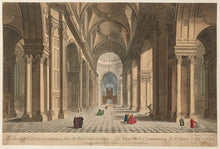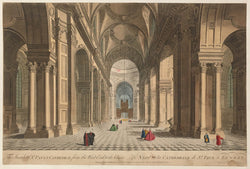Unattributed. “The Inside of St. Pauls Cathedral from the West End to the Choir."
London: Bowles & Carver, 1793-1832. 11 ¼ x 16 ½ (paper). Engraving. Original hand color. Margins trimmed to image and mounted on to 20th century fabric. Fill and tear in bottom margin with some light stains. Else, very good condition.
This print is a perspective view, or vue d’optique, a special type of popular print published in England and on the continent during the eighteenth century. These prints were a form of entertainment meant to be seen through devices called “optical machines,” “optiques,” or “peepshows.” The prints were exhibited by traveling showmen in the streets throughout Europe and would also have been collected by those in the professional and upper classes who had the optical machines at home. This machine used a lens to enhance for viewers the magnification and perception of three-dimensional depth of the prints. A mirror was often used so that the perspective prints could be viewed when laid flat, and this meant the image was viewed in reverse. Therefore, it is not unusual that the scenes shown in these prints were drawn in reverse, and there is also often a title printed in reverse along the top, allowing the viewers to quickly read the title. There was usually further text at the bottom of the prints, often in several languages, which could be read by the operator of the optique for the benefit of his audience. The most characteristic feature of the perspective views is their emphasized linear perspective, done to further intensify the enhanced appearance of depth and illusionistic space in the prints when viewed through an optique. When displayed in the optique, the prints could transport the viewer to a far away place– an unknown city, or perhaps into the midst of a dramatic bit of contemporary history. Another attribute of these prints is their bright, often crude hand coloring, applied boldly so as to show the tints when viewed through the lens. A further delightful aspect of these prints is their at times imaginary settings. The artists who etched them usually copied other prints or paintings and were quite unabashed in their willingness to take a beautiful, unnamed harbor from a painting by Claude Lorraine and call it, for example, Rotterdam. These cheerful and colorful images, with their fascinating history and unusual appearance, make for unusual and appealing eighteenth-century prints, and this is a fine example of the genre.





